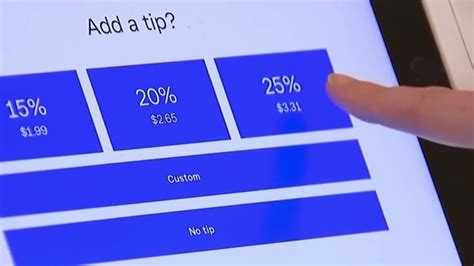
Tipflation is sparking increasing online outrage as tipping requests appear in increasingly unconventional places, with social media users sharing examples of screens soliciting tips for self-service kiosks, retail purchases, and even medical services. A surge in these requests has led to widespread debate about appropriate tipping practices and consumer fatigue.
A growing wave of “tipflation” is engulfing consumers, prompting frustration and ridicule online as tipping requests pop up in unexpected places. Social media platforms are overflowing with images of tipping screens at self-checkout kiosks, retail stores, and even medical facilities, igniting a heated debate about the boundaries of appropriate tipping. This trend, characterized by the proliferation of digital prompts asking for tips, has consumers questioning the value and purpose of the practice.
The trend has been fueled by the widespread adoption of digital payment systems in various industries. While tipping has long been customary in the restaurant and hospitality sectors, its expansion into other areas has raised concerns about wage standards and the financial burden on consumers. “The expectation to tip has seemingly crept into every transaction,” said one user on social media, reflecting a sentiment echoed by many others who feel pressured to tip in situations where they previously wouldn’t have.
One of the primary drivers of this expansion is the ease with which businesses can integrate tipping options into their point-of-sale (POS) systems. With just a few clicks, businesses can add pre-set tip amounts to their payment screens, potentially boosting revenue without necessarily increasing base wages for employees. This practice has been met with skepticism, especially when consumers are asked to tip for services that were once considered part of the standard transaction.
“It’s getting out of hand,” commented another user, highlighting the sense of exasperation felt by many who are confronted with numerous tipping screens daily. The proliferation of these requests has led to concerns about “tip fatigue,” where consumers feel overwhelmed by the constant expectation to add extra payments on top of the initial purchase price.
The debate over tipflation has also touched on the issue of fair wages. Some argue that businesses are using tipping as a substitute for paying employees a living wage. By relying on tips to supplement income, employers may be able to keep labor costs down while transferring the responsibility of fair compensation to consumers. This argument is particularly relevant in states where the minimum wage for tipped employees is significantly lower than the standard minimum wage.
The increase in tipping requests has also raised questions about transparency and accountability. Consumers often wonder where their tips are actually going and whether they are being distributed fairly among employees. Without clear information about how tips are managed and allocated, there is a risk that employees may not be benefiting as much as consumers assume.
The rise of tipflation has prompted a backlash from consumers who are pushing back against what they see as an unfair and unsustainable practice. Some are choosing to opt out of tipping altogether, while others are advocating for businesses to pay their employees higher wages and eliminate the need for tipping.
Examples of “outrageous tipping screens” highlighted online include:
- Self-service kiosks: Prompts to tip at self-checkout machines in fast-food restaurants, coffee shops, and even retail stores, where customers are essentially serving themselves.
- Retail purchases: Requests for tips when buying items such as clothing, books, or household goods, where there is little or no service involved beyond the basic transaction.
- Medical services: Tipping screens at medical offices, pharmacies, and other healthcare providers, raising ethical questions about the appropriateness of tipping in these settings.
- Online orders: Pre-set tip options when ordering food or goods online, even for pick-up orders where the customer is not receiving any delivery service.
- Services with existing fees: Requests for tips on top of service fees or delivery charges that are already included in the bill.
The increased visibility of these tipping requests has sparked a broader conversation about the role of tipping in society and the responsibilities of businesses to provide fair compensation to their employees. As tipflation continues to spread, it is likely that the debate over tipping practices will only intensify. The conversation has extended to social media platforms such as Reddit, X, and TikTok, where users share their experiences and frustrations with the evolving tipping landscape.
One notable example is a tipping screen at a veterinary clinic, requesting tips for services rendered to pets. This scenario has raised questions about the ethical implications of tipping in the healthcare sector, even for animals. The perception is that healthcare professionals should be adequately compensated through standard fees, rather than relying on tips from clients.
Another frequently cited example is tipping at self-checkout kiosks. Customers argue that they are performing the work of a cashier by scanning and bagging their own items, so there is no justification for adding a tip. The expectation to tip in these situations is seen as an attempt by businesses to increase revenue without providing additional service or value.
The rise of tipflation has also led to discussions about the psychological impact of tipping requests. Some studies have shown that consumers feel pressured to tip, even when they don’t believe it is warranted, due to social norms and fear of judgment. This pressure can lead to anxiety and resentment, especially for those who are already struggling to make ends meet.
In response to the growing backlash, some businesses have begun to re-evaluate their tipping policies. Some are opting to increase base wages for employees and eliminate tipping altogether, while others are exploring alternative compensation models. However, the transition away from tipping is not without its challenges, as it may require businesses to raise prices or reduce staff in order to offset the increased labor costs.
The long-term impact of tipflation on consumer behavior and business practices remains to be seen. However, it is clear that the issue has struck a nerve with many consumers, who are demanding greater transparency and fairness in the way they are asked to compensate service providers. The ongoing debate is likely to shape the future of tipping in the United States and other countries where the practice is prevalent.
The situation is further complicated by the varying state and local laws regarding minimum wage and tipping regulations. In some areas, tipped employees are allowed to be paid a lower minimum wage, with the expectation that tips will make up the difference. This creates a system where the financial burden is shifted to consumers, who are essentially subsidizing the employer’s labor costs.
The spread of tipflation also raises questions about the potential for abuse and exploitation. Without proper oversight and regulation, there is a risk that businesses may manipulate tipping practices to maximize profits at the expense of both consumers and employees. For example, some businesses may fail to properly distribute tips to employees, or they may use tips to offset other business expenses.
The issue of tipflation is not limited to the United States. Similar trends have been observed in other countries, particularly those with a strong tipping culture. In Canada, for example, consumers are increasingly being asked to tip for services that were previously not subject to tipping, such as takeout orders and retail purchases.
The debate over tipflation has also highlighted the need for greater financial literacy among consumers. Many people are unaware of the underlying economics of tipping and the various factors that influence wage levels and business practices. By educating consumers about these issues, it may be possible to foster a more informed and constructive dialogue about the role of tipping in society.
As the trend continues to evolve, it is likely that new and innovative approaches to compensation will emerge. Some businesses are experimenting with alternative models, such as service charges or revenue sharing, that aim to provide fair wages to employees without relying on tips. These approaches may offer a more sustainable and equitable solution to the challenges posed by tipflation.
The backlash against tipflation also underscores the importance of consumer advocacy and activism. By speaking out against unfair or exploitative practices, consumers can help to hold businesses accountable and push for meaningful change. Social media platforms have become powerful tools for organizing and mobilizing consumer sentiment, allowing individuals to share their experiences and collectively demand reform.
In conclusion, the phenomenon of tipflation represents a significant shift in the landscape of consumer transactions. The increasing prevalence of tipping requests in unexpected places has sparked widespread outrage and debate, raising questions about wage standards, transparency, and the overall fairness of the practice. As consumers continue to grapple with the implications of tipflation, it is essential that businesses, policymakers, and individuals engage in a thoughtful and constructive dialogue to find solutions that benefit all stakeholders. The future of tipping will likely depend on the willingness of these groups to work together to create a more equitable and sustainable system.
Frequently Asked Questions (FAQs) about Tipflation:
1. What exactly is “tipflation” and how does it differ from traditional tipping?
Tipflation refers to the recent trend of businesses expanding tipping requests to situations where they were not previously common or expected. Unlike traditional tipping, which is typically associated with service-oriented industries like restaurants and hospitality, tipflation involves tipping prompts appearing at self-checkout kiosks, retail stores, online orders, and even medical facilities. The key difference lies in the context: traditional tipping is often tied to exceptional service, while tipflation often involves tipping for basic transactions or self-service options. It represents a perceived inflation of the tipping culture, where consumers are feeling pressured to tip in more and more situations.
2. Why are we seeing more tipping requests in places where it wasn’t common before?
Several factors contribute to the rise of tipflation. Firstly, the widespread adoption of digital payment systems has made it easy for businesses to add tipping options to their point-of-sale (POS) systems. These systems often come pre-programmed with tipping prompts, making it effortless for businesses to solicit tips. Secondly, some businesses may be using tipping as a way to supplement employee wages, particularly in states where the minimum wage for tipped employees is lower than the standard minimum wage. By relying on tips, employers can potentially keep labor costs down. Thirdly, the COVID-19 pandemic may have played a role, with some consumers feeling more inclined to support businesses and service workers during challenging times. However, even as the pandemic has subsided, the trend of increased tipping requests has persisted.
3. Are employees actually benefiting from the increase in tipping requests, or is it mainly benefiting the businesses?
The extent to which employees benefit from tipflation is a complex and often debated issue. While some employees may see an increase in their overall income as a result of more frequent tipping, there is no guarantee that all tips are being distributed fairly or that they are adequately supplementing wages. Some businesses may use tips to offset other costs, such as equipment maintenance or operating expenses, rather than passing them on to employees. Additionally, there is a lack of transparency in many cases, making it difficult for consumers to know exactly where their tips are going. The ultimate impact on employees depends on factors such as the employer’s tipping policies, the local minimum wage laws, and the overall business climate.
4. What can consumers do to push back against tipflation if they feel uncomfortable with the increased requests?
Consumers have several options for pushing back against tipflation. Firstly, they can choose to opt out of tipping altogether in situations where they don’t feel it is warranted. It is perfectly acceptable to select the “no tip” or “custom tip” option on a tipping screen. Secondly, consumers can voice their concerns to businesses directly, either by speaking to a manager or by leaving feedback online. This can help to raise awareness of the issue and encourage businesses to re-evaluate their tipping policies. Thirdly, consumers can support businesses that pay their employees fair wages and eliminate the need for tipping. By patronizing these businesses, consumers can help to create a more sustainable and equitable system. Fourthly, consumers can advocate for policy changes at the local, state, or federal level, such as increasing the minimum wage for all workers or implementing stricter regulations on tipping practices. Finally, using social media to share experiences and organize collective action can raise broader awareness and potentially influence business practices.
5. What are some alternative compensation models that businesses could use instead of relying so heavily on tipping?
Several alternative compensation models can provide fair wages to employees without relying on tips. One option is to increase base wages for all employees, ensuring that they are earning a living wage regardless of tips. This may require businesses to raise prices or reduce staff, but it can create a more stable and predictable income for employees. Another option is to implement a service charge, which is a fixed percentage added to the bill that is distributed among employees. This provides a more transparent and consistent source of income for employees, while also eliminating the pressure on consumers to decide how much to tip. A third option is to explore revenue sharing, where employees receive a percentage of the business’s overall revenue. This can incentivize employees to provide excellent service and contribute to the success of the business. Employee ownership models can also empower workers and align their interests with the long-term success of the company.









